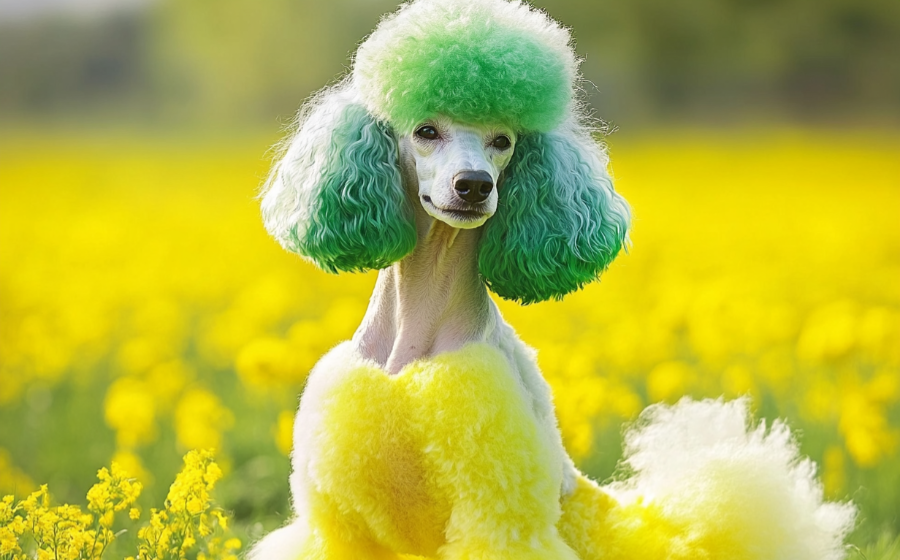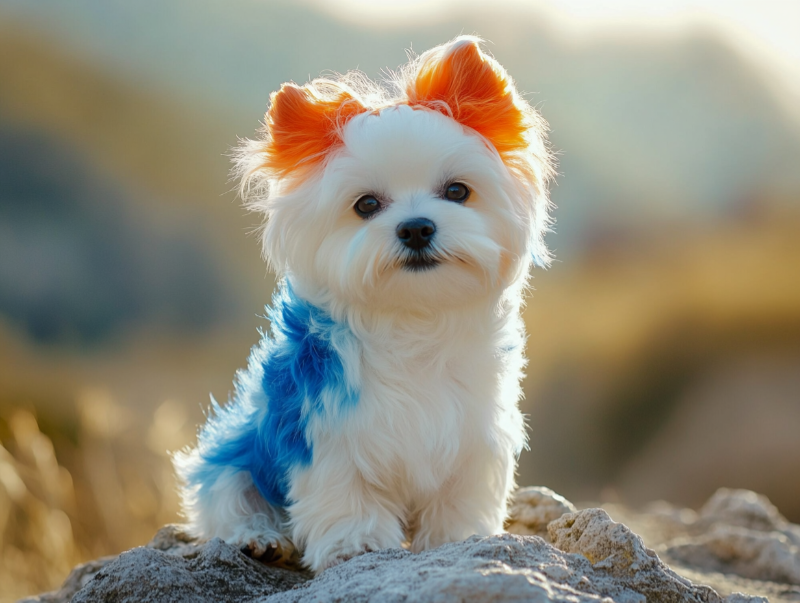Dying your dog’s fur with bright, funky colors can be a fun way to express their personality, but many commercial dog dye brands fail to provide complete transparency about the ingredients in their products. While the idea of giving your pet a unique look may seem harmless, it’s crucial to understand the potential risks these chemicals could pose to your dog’s health.

The Lack of Transparency in Dog Dyes
Many popular dog dye brands, such as Crazy Liberty, Critter Color, and Artero Colorex, fail to provide a full list of ingredients or clear information about where their pigments come from. While Opawz does offer transparency regarding their ingredients, many of these dyes still contain chemicals that could cause skin irritation, allergic reactions, and more severe health issues.
Crazy Liberty Dye Ingredients:
- Aqua (Water): Safe for pets, as it is the most common base in cosmetic products.
- Benzyl Alcohol: Used as a preservative, this can be an irritant at high concentrations. It may cause skin irritation, redness, and discomfort if overused.
- Dimethylpolysiloxane Emulsion: A silicone compound commonly used in cosmetics and hair products. It’s generally considered safe, but it can cause buildup on the skin and fur, which may lead to irritation or clogging pores.
- Lactic Acid & Glycolic Acid: These are exfoliating acids used in many skincare products, and while they are effective for exfoliation, they can irritate sensitive skin. If your dog has broken or irritated skin, these acids should be avoided.
- Hydroxyethyl Cellulose & Carbomer: Thickeners often used in gels or lotions. These ingredients are generally safe, but they can cause irritation if the dog has sensitive skin.
- Sodium Citrate: This is a pH adjuster used to balance the formula. It’s considered safe, but large amounts could potentially cause irritation on sensitive skin.
These ingredients suggest that the product may not be as natural as it claims. While some of these compounds are generally safe in cosmetic formulations, the lack of clear information on the pigment source is a red flag.

Critter Color Dye Ingredients:
- H2O (Water): Safe for pets, as it serves as the base for the formula.
- Carbopol: A thickening agent that is generally safe for pets, though it can cause mild skin irritation in some cases.
- TEA (Triethanolamine): Used to balance pH, TEA is a compound that can be irritating, especially in high concentrations or with prolonged exposure. It is also considered a potential carcinogen by some studies.
- Caprylyl Glycol: A skin-conditioning agent commonly found in cosmetics and skincare products. It’s generally safe but may cause mild irritation for sensitive pets.
- Phenoxyethanol: This preservative is used to prevent bacterial growth. It’s safe in low concentrations, but in higher amounts, it may cause skin irritation or allergic reactions.
- Hexylene Glycol: A solvent used to dissolve other ingredients. It may cause mild irritation, especially for sensitive pets.
- Polysorbate 20: An emulsifier that helps ingredients blend together. While it’s generally safe, it may contain trace impurities that can lead to irritation for some pets.
This product is also concerning due to the use of TEA, which can be irritating and has potential carcinogenic effects. While most of these ingredients are generally safe in small amounts, the lack of transparency regarding pigments makes it hard to gauge the overall safety.
Opawz Dye Ingredients:
- Aqua (Water): Safe for pets, as it’s the base for the product.
- Xanthan Gum: A natural thickener often used in food and cosmetics. It’s generally safe but can cause mild irritation in rare cases.
- Glycerin: A humectant used to hydrate and lock moisture into the skin and fur. It is safe for pets.
- PEG-40 Hydrogenated Castor Oil: An emulsifier that helps blend oil and water. It’s generally safe but could cause mild irritation in some individuals. The PEG process may also introduce impurities, making it a potential concern.
- Alcohol Denat (Denatured Alcohol): Can be drying and irritating, particularly for sensitive skin. Prolonged use may disrupt the skin’s natural barrier.
- Citric Acid: Used to adjust the pH of the product. Generally safe, but it may cause irritation if used in large amounts or on very sensitive skin.
- Hydroxyethylcellulose: A safe thickener commonly used in cosmetic products.
- Polyquaternium-10: A conditioning agent that provides smoothness. Typically safe but could cause buildup on fur over time.
- CI 42090 (Brilliant Blue FCF): A synthetic dye that is generally considered safe for use in cosmetics and food. However, it may cause allergic reactions in sensitive individuals.
- CI 15985 (Sunset Yellow FCF): This synthetic dye has been linked to hyperactivity in children and may trigger allergic reactions in some pets.
- CI 19140 (Tartrazine): Known to trigger allergic reactions, particularly in pets sensitive to aspirin.
- CI 16035 (Allura Red AC): A synthetic dye that may cause allergic reactions and is associated with hyperactivity in some cases.
While Opawz provides ingredient transparency, several synthetic dyes used in their formula have been linked to allergic reactions, skin irritation, and other concerns. Additionally, the presence of alcohol and PEG-40 Hydrogenated Castor Oil can lead to dryness and irritation on your pet’s skin, especially if they have sensitive skin or conditions like dermatitis.

Why These Ingredients Are Dangerous:
Many of the chemicals in these dyes have been linked to:
- Carcinogenic Risks: Some ingredients, like Triethanolamine (TEA), are considered potential carcinogens and may cause long-term health issues if your dog is exposed to them repeatedly.
- Skin and Organ Toxicity: Ingredients such as Phenoxyethanol and Hexylene Glycol can cause irritation to your dog’s skin and internal organs if absorbed.
- Hormonal Disruption: Some chemicals in these dyes can interfere with hormone production, affecting your pet’s overall health.
- Allergic Reactions: Many of the synthetic dyes and preservatives can cause allergic reactions, leading to redness, itching, and swelling.

What You Can Do Instead:
If you’re still determined to dye your dog’s fur, consider exploring natural, safer alternatives. Natural plant-based dyes are non-toxic, and you can avoid exposing your pet to harmful chemicals. For more information on how to safely dye your dog using natural ingredients, check out our article on the natural way to dye your dog.
Conclusion:
Commercial dog dyes may look fun and harmless, but they could be putting your pet at risk of severe health consequences. With potentially toxic ingredients that can cause skin irritation, allergies, and even carcinogenic effects, it’s essential to reconsider using these products. Instead, look for natural and transparent alternatives that prioritize your dog’s health and safety.


